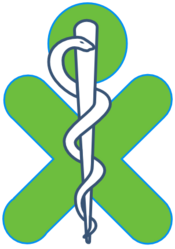Vision screening
Translate this page with Google -español -български -中文(中国大陆) -中文(臺灣) -hrvatski -čeština -dansk -Nederlands -suomi -français -Deutsch -Ελληνικά -हिन्दी -italiano -日本語 -한국어 -norsk -polski -português -română -русский -svenska
Why vision screen?
The goal of the lay person's screening is to help detect visual acuity (and other) problems, and connect those screened with an eye care professional so that they can receive a complete eye exam by a doctor.
Rough numbers
The common: Something vaguely like 1/5 of children have a visual acuity of 20/40 or worse in their best eye (though in some regions there are 10x fewer such). Most of this is due to refractive error, with amblyopia a distant second[1]. So, in many but not all countries, many kids need glasses. There absence can interfere with reading and learning (in something vaguely like 1/2 of cases?).
The severe: Something like 1/1000 children is blind[2], with something vaguely like 1/2 of this being preventable or treatable. It is not clear how much contribution OLPC-related school-age screening can make, as earlier intervention is more effective.
- Perhaps use OLPC students to screen younger pre-school children?
These numbers could use citations and less fuzziness.
Resources
WHO VISION 2020 main site
WHO VISION 2020 Latin America regional site (en, es, pt)
VISION, a 16-page teaching guide from the US NIH, National Eye Institute
Protocols
Some international standards, lots of local variation.
When children can run tests independently, time is less important than in clinical setting. So time can be traded for more accurate results, and a more enjoyable process.
Resources
- Pediatric eye and vision examination.
- Pediatric eye evaluations.
- Eye examination in infants, children, and young adults by pediatricians.
- Pediatric Vision Screening for the Family Physician
- Minnesota DoH's Vision Screening Materials including training manual(PDF) and proceedure summary chart(PDF).
Lay screening:
- http://www.lowvisiononline.unimelb.edu.au/Screening/acuity.htm
- http://www.lowvisiononline.unimelb.edu.au/Screening/acuityNear.htm
- http://www.lowvisiononline.unimelb.edu.au/Screening/testing.htm
Other testing:
Protocols - OLPC-specific opportunities
Screening protocols are built around expected equipment and logistics. We obviously have a nifty additional resource, olpc laptops. OLPC dramatically changes the equipment which can be relied upon to be available. This could both aid in applying existing tests, and create screening opportunities which would otherwise not exist. So in addition to attempting to help with current protocols, we should look for additional useful ways olpc might be used.
A variety of tests seem possible. Some straightforward (such as broken-line vernier acuity), some likely (such as color perception), some may or may not be feasible (astigmatism), some would require additional equipment (a small mirror and cardboard box for binocular perception), and some are more speculative. It may be possible to do some kind of alignment and motility tests, but I'm not sure. Among other things, the laptops have a low-resolution "webcam" camera, which could take 600 pixel wide pictures of each eye. And there is a prototype ~1 dollar lens set to make it into microscope, so close-ups seem possible. The laptops also video conference.
Candidates and discussion
field of view testing
Is this actually useful for target population?
other
- use added macro lens for photographic examination?
- make "astigmatic mirror" into an astigmatism test?
- check for night blindness (vitamin A deficiency)
- look for Bitot's spots (vitamin A deficiency)
Optotypes
Display and illuminance
Visual acuity
Visual acuity charts screen for near sightedness, far sightedness, astigmatism, and anisometropia (visual acuity differences between the two eyes).
See Visual Acuity activity.
Stereo acuity
Random Dot E (RDE), Stereobutterfly stereopsis
Stereo-acuity is a good instrument for the measurement of fusion. But traditionally expensive and hard to conduct. If a child has poor stereo-acuity caused by strabismus, that deviation should be detected with properly performed cross cover testing. So it's normally secondary to corneal light reflex/cover testing.
Color vision
Near vision
Near vision is said to be more difficult to test with children as the accomodate more easily.
Contrast sensitivity
There is a color object sorting game from Game Jam Boston June 2007 which might be leveraged.
Muscle balance testing
The early childhood years and the early elementary years are critical touch points to screen for amblyogenic risk factors, such as strabismus.
It is important to screen for muscle balance deficiencies and organic factors, especially in children younger than 8 years of age. These include the corneal light reflection and the cross cover test (by using a toy for the child to look at straight on and an occluder).
Other ideas
Children aiding in the screening of younger siblings
1st grade is late for some screening. One possiblity might be for children to help screen younger siblings. Examples (page references are to [3]): Visual acuity can be automated as a game - the child screener just has to create basic lighting and distance conditions. Parent/Teacher Comments And Child's Impression Of Vision (p25) Child And Family Vision History Procedure (p26), Vision History & Questions (p27), Vision Behavior Checklist (p28), are all interview based, and so with xo-based interview training and tools, should be doable. External Inspection (p29), Monocular Fix And Follow / Extra Ocular Movements (p35), Binocular Fix And Follow / Extra Ocular Movement (EOM) (p36), Cross cover (p37), might be done by taking xo images/video, which is then later analyzed off-site.
A general approach might be that of looking at what lay health workers are trained to do, and searching for parts of it which, with the addition of the xo as a training and infrastructure aid, become doable by children in the OLPC 6-11 year age range. Perhaps alternately by their older siblings and parents. And use them to reach out to their younger siblings, and other family members, as an addition to existing community health and screening efforts.
See also
- http://www.v2020.org/ WHO VISION 2020
- http://www.uniteforsight.org/
